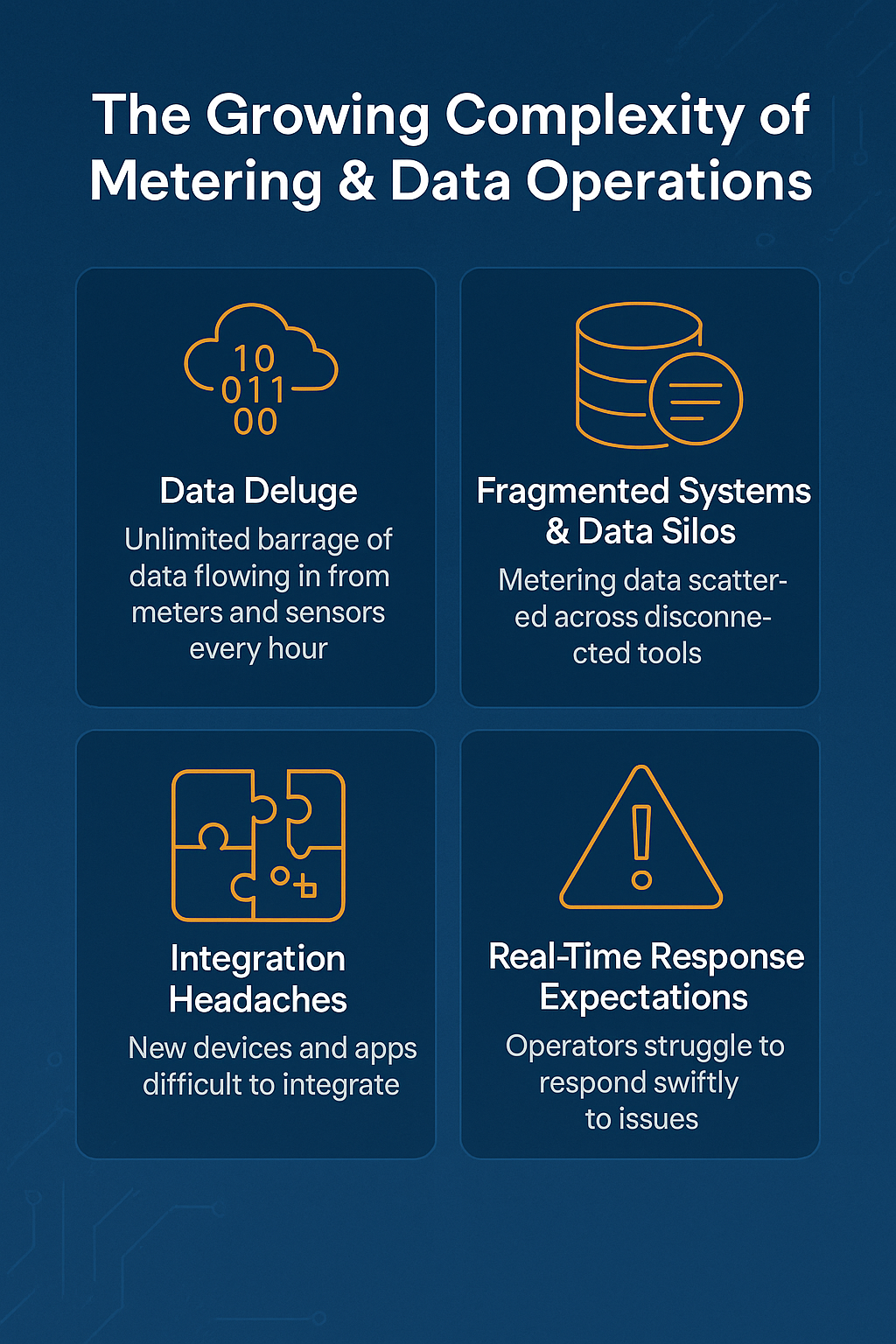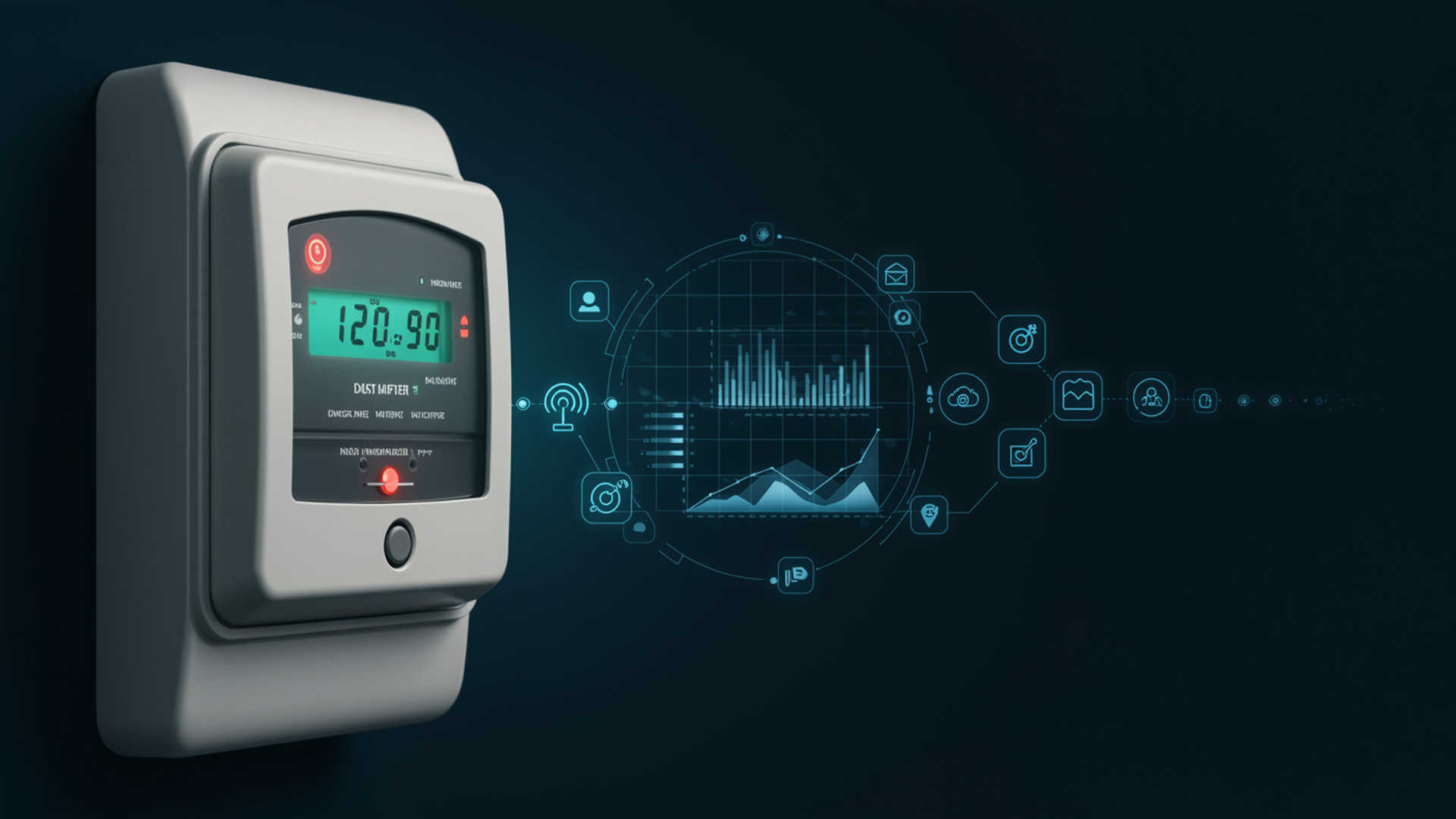
Introduction – A New Kind of Control Room
Not long ago, I walked into a utility’s operations center expecting a state-of-the-art control room. Instead, I found engineers flipping between spreadsheets and late-night manual checks – a far cry from the real-time nerve center one might imagine. It reminded me of a conversation with a utility partner during a major smart meter rollout: “Our ‘dashboard’ is basically an Excel workbook,” they admitted.
This scene underscores an urgent reality across North American utilities: the explosion of smart meter data has outpaced the tools and practices used to manage it. We’re deploying millions of smart meters and IoT sensors that stream data by the minute, yet many teams are still relying on patchwork systems and manual processes to make sense of that data. The result? Data overload, silos, and delayed responses – chaos that begs for clarity.
This is where the Smart Metering Operations Center (SMOC) comes in. As someone who works closely with both technology partners (from device manufacturers to system integrators) and utility executives, I’ve seen firsthand how a SMOC can be a game-changer.
The Growing Complexity of Metering & Data Operations

Smart meters promised to revolutionize energy management – and in many ways they have. Since the first big rollouts in the early 2010s, adoption has surged, with over 1 billion smart meters deployed globally by 2023. These devices now form the backbone of advanced metering infrastructure (AMI), feeding utilities with granular consumption data, voltage readings, outage alerts, and more.
But this progress has a flipside: scale and complexity.
Data Deluge: Today’s energy grids are hyper-connected, with an “unlimited barrage of data” flowing in from meters and sensors every hour. Many smart meters report data every 15 minutes or less. Multiply that by hundreds of thousands or millions of meters, and you get tens of billions of data points pouring in daily. Legacy IT systems were never designed for this volume and velocity – utilities often struggle to store, process, and analyze this firehose of information in real time. The burden on teams is intense, and important signals (like a meter failure or voltage anomaly) can get lost in the noise.
Fragmented Systems & Data Silos: Traditional utility IT architecture is siloed by function. Meter data might reside in a Meter Data Management (MDM) system; network events in a head-end system (HES); customer billing info in a CIS; outage alarms in an OMS; location data in GIS – the list goes on. Each system often speaks a different language, making integration a nightmare. Many utilities still rely on custom middleware or batch processes to bridge these gaps. It’s no surprise that data falls through the cracks. Inconsistent formats and incompatible protocols are common when multiple vendors’ devices and software are in play. The outcome is a fragmented view of operations: teams struggle to get a holistic picture of grid performance when information is scattered.
Integration Headaches: Along with siloed data comes the challenge of tying it all together. Many smart meter networks use proprietary communication networks, increasing vendor lock-in and complicating integration. Even after rollouts, utilities often grapple with managing AMI functions across discrete systems. Interoperability isn’t just a buzzword – it’s a daily hurdle. One major technical challenge is ensuring that different meters, sensors, and software all “talk” to each other seamlessly. Without a unifying layer, integrating new technology can feel like fitting square pegs into round holes.
Real-Time Response Expectations: In the digital age, both regulators and customers expect quick action. When a storm knocks out a neighborhood’s power or a batch of meters stops communicating, utilities need to respond fast. But with the current patchwork systems, operators often discover issues hours or days late – for example, realizing during billing that a cluster of meters hasn’t reported for weeks. Manual data pulls and ad-hoc queries fill the gaps, leading to delays and missed SLAs. These latency issues erode customer trust and can incur regulatory penalties. The grid may be getting “smarter,” but operational workflows haven’t kept pace.
Given this growing complexity, it’s clear why many utility leaders feel they’re drowning in data but thirsty for insights. As one industry article aptly put it, utilities have become a data-driven industry that’s still struggling with fundamental data challenges. This is the pain point a Smart Metering Operations Center is designed to solve.
What is a SMOC and Why Does It Matter?
A Smart Metering Operations Center (SMOC) is more than just a new software tool – it’s an evolved approach to managing metering operations. I like to describe a SMOC as the nerve center of a utility’s metering infrastructure. Think of it as a unified, real-time control room for all things meter data. Instead of engineers piecing together information from multiple systems and outdated reports, a SMOC provides one pane of glass, updated in the moment.
Here’s what sets a true SMOC apart:
Unified Data Hub: A SMOC brings together data from across the metering ecosystem – from raw meter readings and outage alarms in the HES, to validated consumption data in the MDM, to billing statuses, GIS locations, and customer service tickets. This consolidation breaks down silos and creates a single source of truth. When a utility in Australia implemented an early SMOC, they described it as converting numerous discrete systems into one coherent data network. The payoff was immediate: better efficiency, cost savings, and even support for sustainability.
Real-Time Visibility and Alerts: A SMOC offers live visibility into the health of each meter, network segment, and data feed. Operators can see issues as they happen – a meter that goes offline, a network outage, or a voltage anomaly triggers an instant alert. In one case, a SMOC flagged a neighborhood where dozens of meters dropped off the network; operators dispatched a field crew before customer calls came in.
Automation & Workflow Integration: A SMOC doesn’t just display data – it enables action. Advanced setups include automation layers that trigger workflows. For example, one utility automated meter data recovery: the SMOC checks daily for missing reads, pings the HES, and pulls in data automatically. The result? Near 100% data completeness and timely billing – with fewer manual tasks.
Key Challenges a SMOC Can Solve
Let’s drill down on a few persistent challenges and how a SMOC directly addresses them:
Managing Data at Scale: SMOCs ingest, store, and validate data centrally. They catch issues like missing reads automatically and mitigate data loss by re-polling meters or switching communication channels.
Fragmented Data & Lack of Visibility: By consolidating data from MDMs, HES, billing, GIS, CRM, and more, SMOCs give operations teams full context. If there’s an issue, operators see the technical status, location, maintenance history, customer reports, and billing impact – all in one place.
Slow Response and Operational Inefficiencies: Traditional setups require manual steps to respond to outages. SMOCs embed automation: the moment they detect an anomaly, they can log a ticket, notify the right team, or dispatch a crew with relevant info.
Integration and Interoperability Hurdles: As new devices and systems are added, integration becomes tougher. A SMOC functions as an open integration hub (with APIs and adapters), handling multiple protocols and shielding operations from backend quirks.
Delayed Billing and Revenue Leakage: Missing meter reads can delay billing and cause revenue loss. SMOCs help close these gaps by integrating meter operations with billing systems, ensuring complete and timely data flow.
Compliance and SLA Management: SMOCs simplify compliance with built-in analytics and reporting tools that track key performance indicators in one place.
Collaboration: The Ecosystem Driving SMOC Success
While the SMOC concept is powerful, realizing it requires deep collaboration across the utility ecosystem. It’s not a single-vendor silver bullet – it’s a team sport involving tech providers, system integrators, and utility leadership.
Why is collaboration crucial? Consider the components: smart meters (from vendors like Itron, Kamstrup, ABB), communications networks (RF mesh, cellular, IoT), HES and MDM software, legacy systems (CIS, SCADA), and the SMOC platform that ties it together. No single player provides it all. Success happens when every stakeholder focuses on their strengths and ensures interoperability.
For example, meter manufacturers may also provide the HES. System integrators (like Accenture or Deloitte) help stitch everything together. At Grid, we provide the unifying layer – connecting systems and turning siloed data into real-time insights.
Utilities that succeed with SMOC initiatives treat their vendors and teams as strategic partners. They establish working groups with metering engineers, IT architects, vendors, and integrators aligned on solving real problems – like improving first-time connects or reducing estimated bills. In such settings, open standards are essential: the SMOC must ingest data from any source and work with any hardware.
This openness benefits everyone: utilities get flexibility, and vendors gain relevance by integrating into a broader ecosystem. It’s a win-win.
If you’re a technology provider or utility leader, we’d love to learn from your experience. Share your insights or questions below – and let’s spark a conversation that moves our industry forward, together. Turning chaos into clarity starts with shared stories::
- What have been the biggest two or three hurdles in your journey of unifying smart meter data across systems?
- Was it vendor integration, internal coordination, or something else entirely?



.jpg)








